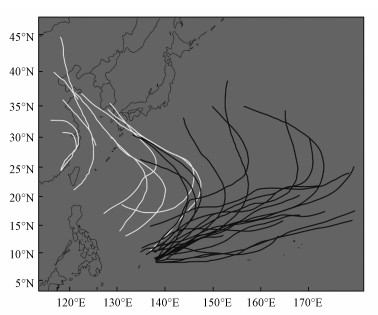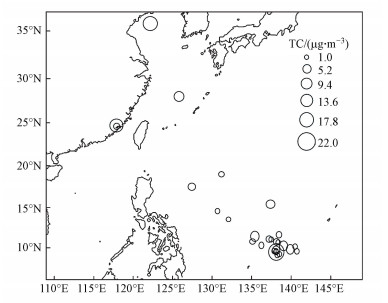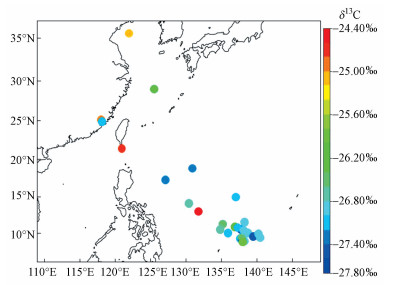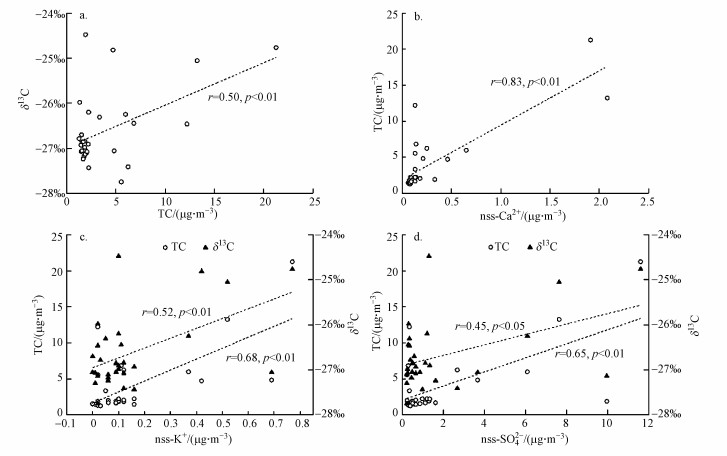2. 迈阿密大学罗森斯蒂尔海洋和大气科学学院, 佛罗里达 33149;
3. 东华理工大学水资源与环境工程学院, 南昌 330013;
4. 东华理工大学地球科学学院, 南昌 330013;
5. 中国科学院南海海洋研究所热带海洋环境国家重点实验室, 广州 510301
2. Rosenstiel School of Marine and Atmospheric Science, University of Miami, Florida 33149;
3. School of Water Resources and Environmental Engineering, East China University of Technology, Nanchang 330013;
4. School of Earth Sciences, East China University of Technology, Nanchang 330013;
5. State Key Laboratory of Tropical Oceanography, South China Sea Institute of Oceanology, Chinese Academy of Sciences, Guangzhou 510301
海洋气溶胶是海洋大气中极其重要的组成部分, 主要由一次、二次有机和无机气溶胶组成, 它不仅可以通过改变太阳辐射平衡来影响地球环境, 还可以间接地影响碳的生物地球化学循环过程, 进而对海洋生态系统和全球气候产生潜在的影响(Miyazaki et al., 2010;2011;张麋鸣等, 2013;Xiao et al., 2018).
稳定碳同位素(δ13C)常用来示踪大气气溶胶中碳的来源(Kawamura et al., 2004;Górka et al., 2014;Vodička et al., 2019).不同来源的稳定碳同位素组成存在较大的差异, 如Widory等(2006)研究报道煤燃烧产生的δ13C为-22.9‰~-24.9‰, 而Ancelet等(2011)发现与煤燃烧相比, 机动车尾气排放的δ13C较为偏负, 其δ13C值为-24.7‰~-28.3‰;Turekian等(1998)研究发现, C3植物燃烧释放的δ13C为-27.2‰~-30.0‰, 但C4植物燃烧释放的δ13C范围与C3植物相差较大, 其δ13C为-11.5‰~-13.5‰(Martinelli et al., 2002).由海洋释放到大气的碳, 其δ13C为-20‰~-22‰(Fontugne et al., 1978;Fry et al., 1998).由于不同来源的δ13C存在差异, 因此, δ13C值常用于示踪内陆城市、沿海地区等气溶胶中TC的来源.Cao等(2011)利用δ13C示踪中国14个城市PM2.5中碳的来源, 认为主要来源于化石燃料, 特别是煤燃烧和机动车尾气排放;并认为在中国北方城市, 冬季主要受到燃煤的影响.周一鸣等(2018)报道了南京春季北郊地区TC主要受煤燃烧和机动车尾气排放的影响, 与Cao等(2011)的研究结果具有较好的一致性.Mkoma等(2014)对坦桑尼亚PM2.5和PM10中总碳的δ13C值进行测定分析, 发现PM2.5和PM10中C3植物燃烧对TC的贡献分别为42%~74%、39%~64%, C4植物燃烧对TC的贡献分别为26%~58%、36%~61%, 表明C3和C4植物燃烧是坦桑尼亚PM2.5和PM10中TC的主要污染物来源.不同海域的气溶胶其来源也不同, 如Xiao等(2018)报道了南海永兴岛气溶胶中TC主要来源于大陆的生物质燃烧和化石燃料燃烧.而Kunwar等(2016)研究了位于西北太平洋边缘区域冲绳岛气溶胶中的TC, 发现煤燃烧对西北太平洋冲绳岛冬季气溶胶中TC的贡献高达97%, 且主要来源于大陆的煤燃烧.这说明南海气溶胶中的碳主要受到东南亚国家生物质燃烧和中国东部地区化石燃料燃烧的影响, 西北太平洋则受到东北亚煤燃烧的影响.
近几年, 随着亚洲地区经济和人口的快速发展, 越来越多的大气污染物排放到大气中, 对亚洲地区的大气环境造成了严重的影响(肖红伟等, 2014).气团在远距离大气传输过程中, 途经人为污染严重的上空区域, 将携带其排放的矿物尘埃和人为来源输送到海洋区域, 进而影响偏远海域海洋大气气溶胶组成(Sasakawa et al., 2002;Jung et al., 2011;Boreddy et al., 2015;Xiao et al., 2017;Xiao et al., 2018).因此, 为了了解西北太平洋海洋大气气溶胶中稳定碳同位素组成及其可能的污染来源, 本研究于2014年12月—2015年3月期间搭载西北太平洋观测航次采集气溶胶样品, 分析气溶胶中TC浓度和δ13C, 探讨其碳组分的主要污染来源及其可能的大气传输过程, 以期为西北太平洋今后的大气气溶胶研究提供更多的数据和依据.
2 材料与方法(Materials and methods) 2.1 样品采集本研究于2014年12月—2015年3月期间搭载西北太平洋观测航次, 使用大流量TSP采样器(型号KC-1000)在“科学”号科考船上收集TSP样品, 该仪器被固定在“科学”号科考船的最上层甲板上进行TSP样品收集, 避免样品受到船的废气污染.此次巡航共收集到31个样品, 每48 h收集一次.采样前将石英纤维滤膜用锡箔纸包好放置在马弗炉内, 425 ℃高温烘烤4 h以去除滤膜中的杂质, 冷却后放于干燥器内至室温, 在恒温恒湿天平室中使用万分之一天平称重后, 再放进自封袋置于干燥器内.所有采集的样品称重后放置于-20 ℃冰箱内保存.
2.2 样品分析使用稳定同位素质谱仪(EA MAT-253 Plus)对本次TSP样品中的TC浓度和δ13C进行测定.首先切取3/256的滤膜样品, 放入锡杯后称重, 再置于仪器进样盘中用于TC浓度和δ13C分析.使用国际参考标准物质USGS-41a(δ13C:37.6‰ VPDB)及工作标准尿素(Thermo, δ13C:-41.3‰)和高粱粉(δ13C:-13.8‰)对δ13C进行校正.各种标准进行多次测量分析, 确定分析精度和误差分别为0.03‰和0.2‰.
2.3 后向轨迹气流分析利用TrajStat软件计算每个采样期间开始时到达该位置气团的5 d后向轨迹来确定大气污染物的远距离传输, 起始时间为上午9:00.图 1为本研究利用美国国家海洋和大气管理局(NOAA)共享的GDAS数据对采样期间的气流进行模拟(http://ready.arl.noaa.gov/HYSPLIT.php).
 |
| 图 1 西北太平洋每个起始采样点的5 d后向轨迹(白色和黑色的线分别代表近岸和远海气溶胶样品) Fig. 1 Five-day backward trajectory for each starting sampling point in the western North Pacific |
西北太平洋冬季TSP浓度如表 1所示, 其平均浓度为(44.8±28.6) μg · m-3, 范围为14.1~136 μg · m-3, 其中, 邻近亚洲大陆的采样点具有较高的TSP浓度(如ST001、ST017, 表 1).前人研究发现, 海洋大气TSP浓度通常比大陆TSP浓度低很多, 如临海地区的Okinawa Island(66.7 μg · m-3)(Kunwar et al., 2016)和东京(107 μg · m-3)(Kawamura et al., 1993).前期研究发现, 西太平洋地区的TSP浓度大都小于50 μg · m-3, 如在1990年研究的西北部至赤道太平洋(48 μg · m-3)(Kawamura et al., 1999)、2007年大西洋和太平洋(36.7 μg · m-3)(Zhang et al., 2010)等.
| 表 1 西北太平洋冬季TSP中TC浓度及其δ13C值 Table 1 TC concentration and its δ13C value in winter TSP in the western North Pacific |
西北太平洋冬季气溶胶中TC浓度变化特征如表 1和图 2所示, 其平均浓度为(4.0±4.4) μg · m-3(范围为1.3~21.2 μg · m-3), 介于西北太平洋Okinawa Island((2.0±0.6) μg · m-3)(Kunwar et al., 2016)和南海永兴岛((6.8±1.5) μg · m-3)(Xiao et al., 2018)之间, 远低于沿海城市如天津((12.6±9.6) μg · m-3)(Ji et al., 2019)、唐山((12.3±9.1) μg · m-3)(Ji et al., 2019)和Mumbai((22.0±4.7) μg · m-3)(Aggarwal et al., 2013)等地(表 2).西北太平洋TC含量在TSP中所占的比例(8.9%)与Gosan(6.6%)(Kawamura et al., 2004)较接近, 远低于东京(21%)(Kawamura et al., 1993)和北京(17%)(Sekine et al., 1992), 但却高于矶岛(1.8%)(Kawamura et al., 2003).
 |
| 图 2 西北太平洋冬季TSP中TC浓度的变化特征 Fig. 2 Variation characteristics of TC concentration in winter in TSP in the western North Pacific |
| 表 2 西北太平洋TSP中的TC浓度及其δ13C值与其他城市的研究对比 Table 2 Comparison of TC concentrations and δ13C values in TSP in the western North Pacific compared with other cities |
根据后向轨迹气团的方向和采样点所在的位置, 本文将西北太平洋冬季气溶胶采样点分为近岸和远海(图 1和表 1).近岸和远海TC的平均浓度分别为(6.0±6.8) μg · m-3(范围为1.5~21.2 μg · m-3)、(3.1±2.7) μg · m-3(范围为1.3~12.2 μg · m-3).近岸的TC浓度相对较高, 可能受到日本、韩国和中国等污染相对严重地区气团的影响(图 1), 由于东北亚地区冬季寒冷, 居民取暖等导致化石燃料和生物质燃烧的排放量显著增加(Cao et al., 2011), 污染物通过大气传输从陆地到达西北太平洋, 导致TC浓度升高.近岸的TC浓度与永兴岛((6.8±1.5) μg · m-3)(Xiao et al., 2018)等较接近, 说明它们可能有着相似的来源, 研究认为永兴岛冬季受到东亚国家污染的影响(Xiao et al., 2018), 与本研究结果较一致.大部分远海TC浓度相对较低, 可能是由于含污染物质的气团在远距离传输时气溶胶的自然沉降及其受到海洋干净大气的稀释所致(图 1).
3.2 西北太平洋冬季气溶胶中δ13C的变化特征西北太平洋冬季TSP中δ13C的变化特征如表 1和图 3所示, δ13C的平均值为-26.6‰±0.8‰(范围为-24.5‰~-27.7‰), 与Okinawa Island(-22.5‰±0.6‰)(Kunwar et al., 2016)、Gosan(-23.1‰±0.4‰)(Kundu et al., 2014)和永兴岛(-22.6‰±0.3‰)(Xiao et al., 2018)等海域地区相比(表 2), 西北太平洋的δ13C值明显偏负.为更好地了解西北太平洋冬季气溶胶来源, 本研究使用几种示踪剂来示踪气溶胶中碳的可能来源.例如, nss-SO42-可用于示踪人为来源(如化石燃料燃烧等), 而nss-K+可用于示踪生物质燃烧等来源(Aggarwal et al., 2013).研究发现, 西北太平洋气溶胶中TC与δ13C之间显著线性正相关(图 4a), 表明西北太平洋气溶胶中TC可能主要受到两种来源的影响.从图 4b可知, TC与nss-Ca2+之间相关性显著, 这表明亚洲粉尘对nss-Ca2+富集有着显著的影响.然而, δ13C与nss-Ca2+/TC之间并没有显著相关性, 说明粉尘在大气进行远距离传输的过程中, 大部分粉尘的碳酸盐会与气溶胶中其他酸性物质发生反应生成CO2, 这一现象与Kunwar等(2016)的研究结果较相似.西北太平洋气溶胶中δ13C、TC与nss-K+(图 4c)都有显著的相关性, 表明TC可能受到了生物质燃烧的影响.Xiao等(2017)研究发现, 2015年1—2月东南亚、中国南部和台湾等受到了大量生物质燃烧的影响.结合本研究的后向轨迹可知, 部分气团主要来自中国东南部, 这与Xiao等(2017)的研究较相似, 说明西北太平洋部分气溶胶可能也受到了陆地生物质燃烧的影响.此外, 还发现δ13C、TC与nss-SO42-(图 4d)之间也存在显著的相关性, 说明西北太平洋TC可能还受到了化石燃料燃烧的影响.这些结果均表明, 西北太平洋冬季气溶胶中的TC主要受到了生物质燃烧和化石燃料燃烧等陆地人为污染源的影响, 但随着传输距离的增加, 其影响逐渐减小.
 |
| 图 3 西北太平洋冬季TSP中δ13C的变化特征 Fig. 3 Variation characteristics of δ13C in winter in TSP in the western North Pacific |
 |
| 图 4 西北太平洋TSP中各参数之间的相关性分析(a.δ13C与TC;b.TC与nss-Ca2+;c.δ13C、TC与nss-K+;d.δ13C、TC与nss-SO42-, 离子数据来自文献(Xiao et al., 2018)) Fig. 4 Correlation analysis between parameters in TSP in the western North Pacific (a.δ13C and TC; b.TC and nss-Ca2+; c.δ13C, TC and nss-K+; d.δ13C, TC and nss-SO42-, Ion data obtained from the literature Xiao et al., 2018) |
近岸和远海δ13C的平均值分别为-26.0‰±1.1‰(范围为-24.5‰~-27.3‰)、-26.9‰±0.4‰(范围为-26.0‰~-27.7‰).其中, 近岸气溶胶的δ13C值与Vavihill(-26.1‰)(Martinsson et al., 2017)和Alert(-25.7‰±0.7‰)(Narukawa et al., 2008)等城市大气气溶胶的δ13C值较接近, 表明它们可能有着相似的来源.近岸的δ13C值还与厦门(-25.9‰)(Cao et al., 2011)、香港(-26.2‰)(Cao et al., 2011)和上海(-25.9‰)(Cao et al., 2011)等中国沿海城市的大气气溶胶δ13C值相似, Cao等(2011)发现这些沿海城市主要受到了机动车尾气的影响.远海的δ13C值与背景点Košetice(-26.7‰±0.5‰)(Vodička et al., 2019)较相似, 表明远海可能受人为活动影响较小.与青岛(-24.6‰)(Cao et al., 2011)等沿海城市相比, 远海的δ13C值更为偏负, 可能是因为气溶胶中的碳在陆地到远洋的远距离传输过程中使得远海的浓度和同位素同时降低.引起远海δ13C值低于近岸气溶胶的原因可能有:与近岸气溶胶相比, 远海气溶胶的δ13C偏负0.9‰, Irei等(2006)推测可能是因为远海气溶胶在远距离传输过程中挥发性有机物(VOC)不断与· OH等自由基反应形成二次有机气溶胶(SOA), 导致远洋大气气溶胶中SOA的比例增加, 但这个过程使得气溶胶中的δ13C偏负;另一方面由于远海气溶胶在传输过程中不断发生沉降, 而且沉降速率远高于SOA的形成速率, 同时偏重同位素优先沉降(Xiao et al., 2015;Xiao et al., 2018), 从而导致远海气溶胶δ13C值偏负.
4 结论(Conclusions)1) 西北太平洋冬季TSP中TC浓度为(4.0±4.4) μg · m-3, 其中, 近岸与远海的TC浓度分别为(6.0±6.8)、(3.1±2.7) μg · m-3, 近岸与远海TC浓度的差异可能是由于不同气团的来源不同导致.
2) 西北太平洋冬季TSP中δ13C平均值为-26.6‰±0.8‰, 近岸与远海的δ13C平均值分别为-26.0‰±1.1‰、-26.9‰±0.4‰, 近岸气溶胶中TC主要来源于大陆的生物质燃烧和机动车尾气, 而远海气溶胶中TC可能与SOA的形成比例相对较高有关.
3) TC、δ13C与nss-K+、nss-SO42-之间的相关性分析表明, 西北太平洋冬季TSP中TC主要受到生物质燃烧和化石燃料燃烧等陆地人为污染源的影响.
致谢: 感谢中国科学院南海海洋研究所的徐维海和钟立峰同志在收集气溶胶样品方面给予的帮助.
Ancelet T, Davy P K, Trompetter W J, et al. 2011. Carbonaceous aerosols in an urban tunnel[J]. Atmospheric Environment, 45(26): 4463-4469. |
Aggarwal S G, Kawamura K, Umarji G S, et al. 2013. Organic and inorganic markers and stable C, N isotopic compositions of tropical coastal aerosols from megacity Mumbai:sources of organic aerosols and atmospheric processing[J]. Atmospheric Chemistry & Physics, 13(9): 20593-20630. |
Agnihotri R. 2015. Stable isotopic and chemical characteristics of bulk aerosols during winter andsummer season at a station in western coast of India (Goa)[J]. Aerosol & Air Quality Research, 15(3): 888-900. |
Boreddy S K R, Kawamura K. 2015. A 12-year observation of water-soluble ions in TSP aerosols collected at a remote marine location in the western North Pacific:An outflow region of Asian dust[J]. Atmospheric Chemistry & Physics, 15(5): 7419-7458. |
Cao J J, Chow J C, Tao J, et al. 2011. Stable carbon isotopes in aerosols from Chinese cities:Influence of fossil fuels[J]. Atmospheric Environment, 45(6): 1359-1363. DOI:10.1016/j.atmosenv.2010.10.056 |
Fontugne M, Duplessy J C. 1978. Carbon isotope ratio of marine plankton related to surface water masses[J]. Earth & Planetary Science Letters, 41(3): 365-371. |
Fry B, Hopkinson J C S, Nolin A, et al. 1998. 13C/12C composition of marine dissolved organic carbon[J]. Chemical Geology, 152(1/2): 113-118. |
Górka M, Rybicki M, Simoneit B R T, et al. 2014. Determination of multiple organic matter sources in aerosol PM10 from Wroclaw, Poland using molecular and stable carbon isotope compositions[J]. Atmospheric Environment, 89(Complete): 739-748. |
Hegde P, Kawamura K, Joshi H, et al. 2016. Organic and inorganic components of aerosols over the central Himalayas:winter and summer variations in stable carbon and nitrogen isotopic composition[J]. Environmental Science & Pollution Research, 23(7): 6102-6118. |
Irei S, Huang L, Collin F, et al. 2006. Flow reactor studies of the stable carbon isotope composition of secondary particulate organic matter generated by OH-radical-induced reactions of toluene[J]. Atmospheric Environment, 40(30): 5858-5867. DOI:10.1016/j.atmosenv.2006.05.001 |
Jung J, Furutani H, Uematsu M. 2011. Atmospheric inorganic nitrogen in marine aerosol and precipitation and its deposition to the North and South Pacific Oceans[J]. Journal of Atmospheric Chemistry, 68(2): 157-181. DOI:10.1007/s10874-012-9218-5 |
Ji D S, Gao M, Maenhaut W, et al. 2019. The carbonaceous aerosol levels still remain a challenge in the Beijing-Tianjin-Hebei region of China:Insights from continuous high temporal resolution measurements in multiple cities[J]. Environment International, 126: 171-183. DOI:10.1016/j.envint.2019.02.034 |
Kawamura K, Ikushima K. 1993. Seasonal changes in the distribution of dicarboxylic acids in the urban atmosphere[J]. Environmental Science & Technology, 27(10): 2227-2235. |
Kawamura K, Sakaguchi F. 1999. Molecular distributions of water soluble dicarboxylic acids in marine aerosols over the Pacific Ocean including tropics[J]. Journal of Geophysical Research Atmospheres, 104(D3): 3501-3509. DOI:10.1029/1998JD100041 |
Kawamura K, Ishimura Y, Yamazaki K. 2003. Four years' observations of terrestrial lipid class compounds in marine aerosols from the western North Pacific[J]. Global Biogeochemical Cycles, 17(1): 1003. |
Kawamura K, Kobayashi M, Tsubonuma N, et al. 2004. Organic and inorganic compositions of marine aerosols from East Asia:Seasonal variations of water-soluble dicarboxylic acids, major ions, total carbon and nitrogen, and stable C and N isotopic composition[J]. Geochemical Society Special Publications, 9: 243-265. DOI:10.1016/S1873-9881(04)80019-1 |
Kundu S, Kawamura K. 2014. Seasonal variations of stable carbon isotopic composition of bulk aerosol carbon from Gosan site, Jeju Island in the East China Sea[J]. Atmospheric Environment, 94(7): 316-322. |
Kunwar B, Kawamura K, Zhu C. 2016. Stable carbon and nitrogen isotopic compositions of ambient aerosols collected from Okinawa Island in the western North Pacific Rim, an outflow region of Asian dusts and pollutants[J]. Atmospheric Environment, 131: 243-253. DOI:10.1016/j.atmosenv.2016.01.035 |
Martinelli L A, Camargo P B, Lara L B L S, et al. 2002. Stable carbon and nitrogen isotopic composition of bulk aerosol particles in a C4 plant landscape of southeast Brazil[J]. Atmospheric Environment, 36(14): 2427-2432. DOI:10.1016/S1352-2310(01)00454-X |
Miyazaki Y, Kawamura K, Sawano M. 2010. Size distributions of organic nitrogen and carbon in remote marine aerosols:Evidence of marine biological origin based on their isotopic ratios[J]. Geophysical Research Letters, 37(6): 460-472. |
Miyazaki Y, Kawamura K, Jung J, et al. 2011. Latitudinal distributions of organic nitrogen and organic carbon in marine aerosols over the western North Pacific[J]. Atmospheric Chemistry and Physics, 11(7): 3037-3049. DOI:10.5194/acp-11-3037-2011 |
Mkoma S L, Kawamura K, Tachibana E, et al. 2014. Stable carbon and nitrogen isotopic compositions of tropical atmospheric aerosols:sources and contribution from burning of C3 and C4 plants to organic aerosols[J]. Tellus Series B-chemical & Physical Meteorology, 66(1): 20176. |
Martinsson J, Andersson A, Sporre M K, et al. 2017. Evaluation of δ13C in carbonaceous aerosol source apportionment at a rural measurement site[J]. Aerosol & Air Quality Research, 17(8): 2081-2094. |
Narukawa M, Kawamura K, Li S M, et al. 2008. Stable carbon isotopic ratios and ionic composition of the high-Arctic aerosols:An increase in δ13C values from winter to spring[J]. Journal of Geophysical Research Atmospheres, 113(D2): 1-8. |
Sekine Y, Hashimoto Y, Nakamura T, et al. 1992. Characterization of atmospheric aerosol components at Beijing, China[J]. Journal of Japan Society of Air Pollution, 27(5): 237-245. |
Sasakawa M, Uematsu M. 2002. Chemical composition of aerosol, sea fog, and rainwater in the marine boundary layer of the northwestern North Pacific and its marginal seas[J]. Journal of Geophysical Research Atmospheres, 107(D24): 1-9. |
Turekian V C, Macko S, Ballentine D, et al. 1998. Causes of bulk carbon and nitrogen isotopic fractionations in the products of vegetation burns:laboratory studies[J]. Chemical Geology, 152(1/2): 181-192. |
Vodička P, Kawamura K, Schwarz J, et al. 2019. Seasonal study of stable carbon and nitrogen isotopic composition in fine aerosols at a Central European rural background station[J]. Atmospheric Chemistry and Physics, 19(6): 3463-3479. DOI:10.5194/acp-19-3463-2019 |
Widory D. 2006. Combustibles, fuels and their combustion products:A view through carbon isotopes[J]. Combustion Theory & Modelling, 10(5): 831-841. |
肖红伟, 龙爱民, 谢露华, 等. 2014. 中国南海大气降水化学特征[J]. 环境科学, 35(2): 475-480. |
Xiao H W, Xie L H, Long A M, et al. 2015. Use of isotopic compositions of nitrate in TSP to identify sources and chemistry in South China Sea[J]. Atmospheric Environment, 109: 70-78. DOI:10.1016/j.atmosenv.2015.03.006 |
Xiao H W, Xiao H Y, Luo L, et al. 2017. Atmospheric aerosol compositions over the South China Sea:Temporal variability and source apportionment[J]. Atmospheric Chemistry & Physics, 17(4): 1-39. |
Xiao H W, Xiao H Y, Luo L, et al. 2018. Stable carbon and nitrogen isotope compositions of bulk aerosol samples over the South China Sea[J]. Atmospheric Environment, 193: 1-10. DOI:10.1016/j.atmosenv.2018.09.006 |
Xiao H W, Xiao H Y, Shen C Y, et al. 2018. Chemical composition and sources of marine aerosol over the western North Pacific Ocean in winter[J]. Atmosphere, 9(8): 298. DOI:10.3390/atmos9080298 |
Zhang M, Chen J M, Wang T, et al. 2010. Chemical characterization of aerosols over the Atlantic Ocean and the Pacific Ocean during two cruises in 2007 and 2008[J]. Journal of Geophysical Research Atmospheres, 115(D22): 1-15. |
张麋鸣, 陈立奇, 汪建君. 2013. 南大洋二甲基硫海-气交换过程研究进展[J]. 地球科学进展, 28(9): 1015-1024. |
周一鸣, 韩珣, 王瑾瑾, 等. 2018. 南京春季北郊地区大气PM2.5中主要化学组分及碳同位素特征[J]. 环境科学, 39(10): 4439-4445. |
 2020, Vol. 40
2020, Vol. 40


